THE BASICS OF SHAOLIN KUNGFU

Grandmaster Wong demonstrating how to move effectively in stances
Many people say that the basics are very important in kungfu training, but not many know what actually these basics are. They mistakenly think that practicing the basics means practicing kungfu sets. Ironically, though they have this mis-conception, they often only practice kungfu sets throughout their kungfu career without practicing other aspects of kungfu.
In our school, solo set practice is not the basic. They are many things we need to train before solo set practice, and these include entering Zen, chi flow, stances and footwork, flexibility and kicks, fundamental patterns, spacing and timing, and exploding force.
Interestingly, some of what we regard as basics, like entering Zen, chi flow and exploding force, are considered advanced by many other kungfu schools and hence are learnt only at the advanced stage of their kungfu training. Some, like spacing and timing, are seldom taught in other kungfu schools.
To us, “basics means very important, forming the foundation upon which all future development depends. If your basics are not sound, not only your future development will be hampered, you may even derive harmful effects rather than benefits from your training. This, indeed, happens to many unwitting practitioners, and unfortunately they normally are unaware of it. Thus, many practitioners develop knee injuries and energy blockages due to their faulty footwork and habitually tensing their muscles in their training.
Zen and Chi Flow
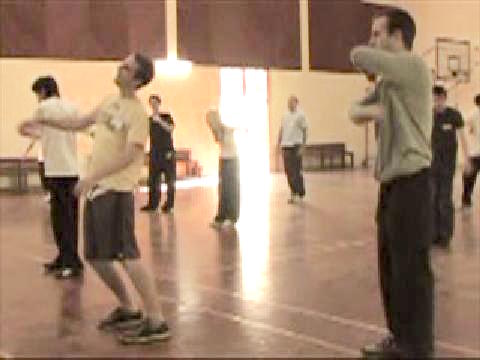
In many ways this is the most important lesson in our kungfu training. Hence, it is always taught right at the beginning. Because our students are able to enter Zen and generate an internal chi flow, all our kungfu practice is a training of mind and energy. Amongst other benefits, our kungfu training gives us mental clarity and good health.
Stance Training
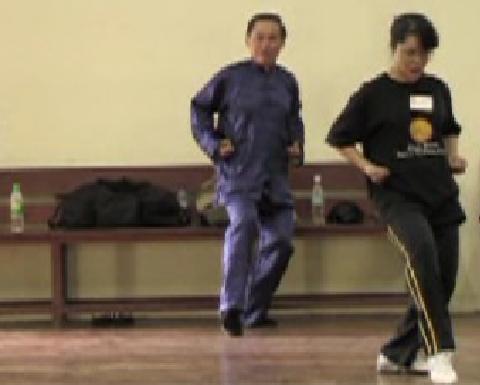
The single most important category of exercises to develop internal force is stance training. However, many students perform it incorrectly. Not only they do not derive benefits, they may have adverse side-effects. One common adverse side-effect is knee injury, which may be caused by performing the False Leg Stance wrongly. If you listen to your body, if a stance is performed wrongly, you could feel energy blockage somewhere in your body. If you perform False Leg Stance wrongly, it is likely that you will feel blockage at your ankles, knees and hips
The Bow-Arrow Stance
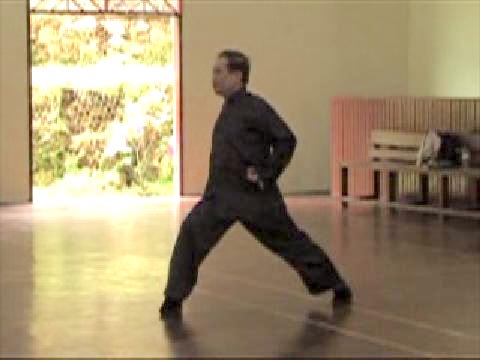
The way we perform the Bow-Arrow Stance is quite different from that performed in many other schools. In our school, the front foot and the back foot are in line, whereas in others they are slightly apart. Both our feet point inward at about 45 degrees, whereIn other schools the front foot points ahead and the back foot points sideways. It is also important not to bend your front knee beyond your font toes, otherwise you may injure your knee.
Three-Circle and Golden Bridge
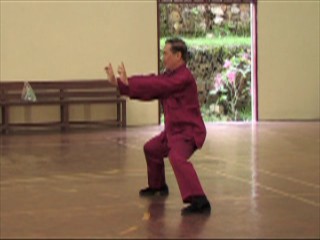
Three-Circle Stance and Golden Bridge are the most popularly used stance for developing internal force in Taijiquan and Shaolin Kungfu respectively. Stance training is simple, but not easy. There are only two steps — ensure that the position is correct, and follow the three golden rules of relax, relax and relax. Stance training should never be an endurance test.
Art of Flexibility
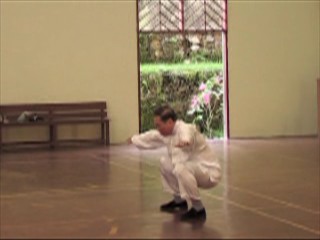
Besides stance training, you should also train the art of flexibility, which consists of five exercises, namely “Three Levels to the Ground”, “Dancing Crane”, Touching Toes”, “Dragon Fly Plays with Water” and “Immortal Takes off Shoes”.. They are chi kung exercises and not merely leg stretching, which is only one of the many benefits.
Moving about effectively in stances

The term “mabo” is often heard in kungfu. Some people think that it refers to the Horse-Riding Stance. This is only part of its meaning. Some think that it refers to stances. This is only half the meaning. “Mabo” is a compound word composed of two terms, “ma” which means “stances”, and “bo” which means footwork. Here Grandmaster Wong teaches some basic “mabo” movements.
Fa-Jing or Explode Force
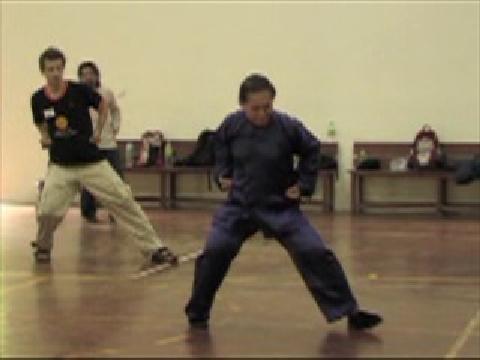
Fa-jing or explode force can be executed with any patterns. In Shaolin Kungfu a useful pattern for this purpose is “Black Tiger Steals Heart”. When you have acquired the skill of fa-jing, using “Black Tiger Steals Heart”, you can apply this skill in other patterns, including defend patterns. There are three requirements for exploding force. Naturally, you must have internal force to explode. Secondly, you must execute the skill using the right mechanics. Thirdly, you must be physically and mentally relaxed. Here, Grandmaster Wong demonstrates the mechanics needed to explode force using “Black Tiger Steals Heart”.
Movement from the Waist
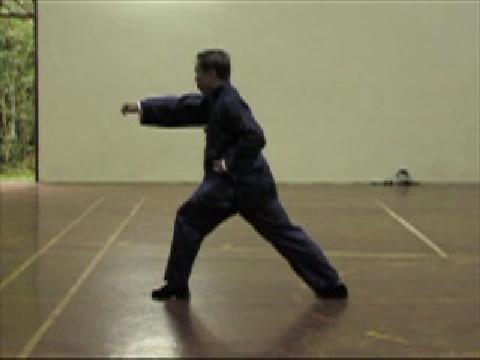
“Movement from the Waist” is a kungfu expression often heard but seldom understood. The waist movement harmonies with the leg movement and the hand movement, constituting the three external harmonies. These three harmonies are important in fa-jing, or explode force, and is manifested in the principle of “starting from the back leg, rotating the waist, and completing at the hand”, as shown here by Grandmaster Wong in exploding force using the pattern “Black Tiger Steals Heart” and “Poisonous Snake Shoots Venom”.
Internal Force is Exploded from Dan Tian
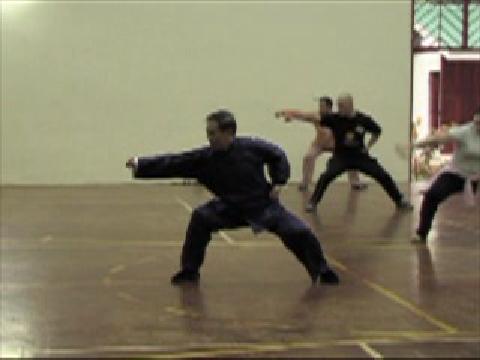
An important tenet in “fa-jing” or “explode force” is “keng yow tan tien fatt” (Cantonese pronunciation), which means “internal force is exploded from the dan tian”. To facilitate this, apply the principle of “start from the back foot, rotate from the waist, and complete at the hand”. Here Grandmaster Wong leads the class in “fa-jing” using the pattern “Precious Duck Swims through Lotus”.
Force and Flow in Every Move
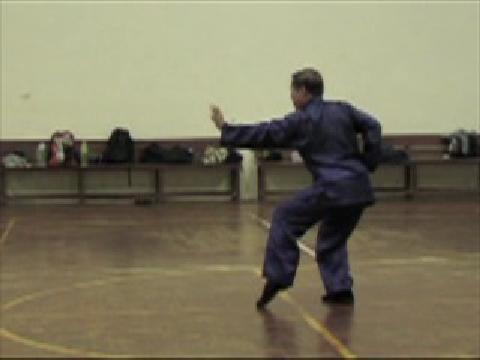
Once you have acquired the skill of “fa-jing” or explode force, which uses flowing energy and not muscular strength, you can perform any pattern flowingly and forcefully. This means you can be forceful, fast yet not panting. This skill, of course, can be transferred to our daily life. In other words, you can work hard physically or mentally for a long time and not become tired! Here, Grandmaster Wong demonstrates exploding force in other patterns.
Linking Patterns to Form Patterns
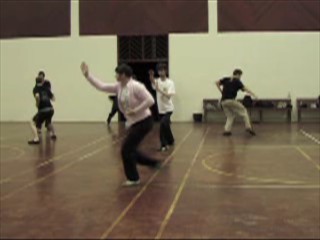
When you can perform individual patterns well, i.e. with correctness of form, reasonable force and fluidity of movement, you can link them into a sequence. This video clip shows course participants linking the patterns they have just learnt into a sequence. The numerous patterns in a sequence should be performed smoothly as if they were one long continuous pattern.
One-Step Sparring
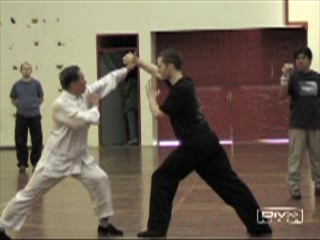
When you can perform patterns with correctness of form, reasonable force and fluidity of movement, you can apply them in combat. Combat application must be learnt and practiced systematically. First, you practice using miscellaneous techniques in one-step sparring. Initially the sparring is pre-arranged with full control. Gradually and systematically the control is released, as is shown here where the responder does not know beforehand which side the initiator will attack. He learns to respond correctly and spontaneously.
Footwork and Spacing
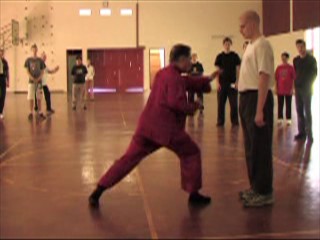
Footwork and spacing are two important aspects in combat. They should be systematically trained, not just left to be acquired haphazardly. Here Grandmaster Wong teaches the class to assess by how many spaces an opponent is away, and how to move in swiftly and safely with appropriate footwork.
Exploding Force in Kicks
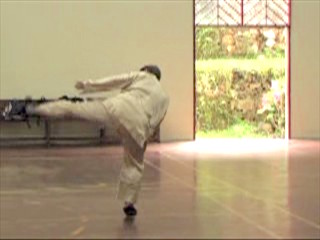
Kicks are important in combat, and there are a wide range of kicks in Shaolin Kungfu. Here Grandmaster Wong demonstrates a side-kick using a pattern called “Happy Bird Hops up Branch”. Balance is essential in executing kicks successfully as well as in defending against an opponent's counters against your kicks. Grandmaster Wong advises that the chest should be relaxed and the mouth open when exploding force in a kick.
Yellow Bird and Naughty Monkey

In this video clip Grandmaster Wong demonstrates two of the basic Shaolin kicking techniques, namely organ-seeking kick and whirlwind kick, using the patterns “Yellow Bird Drinks Water” and “Naughty Monkey Kicks at Tree” respectively. These two kicks are deadly — they can maim or kill in just one move.
We wish to thank Mr Godfery Kissey of Ogingo Videography, Penampang, Sabah, Malaysia for kindly provideing us with the videos. (Godfery is also a member of our Shaolin Wahnam Family.) His telephone number is 60-88-731788, and e-mail address is godfery@pc.jaring.my.
LINKS
Review of the Intensive Shaolin Kungfu Course in Sabah in March 2007
- Overview 1 : The Fundamentals
- Overview 2 : The 16 Combat Sequences
- Overview 3 : Are They Performing Kungfu Dance?
- The Basics of Shaolin Kungfu Training
- Fundamental Combat Skills
- Defeat you Hand to your Opponent, Victory you Create Yourself
- Avoiding Disadvantages and Seeking Advantages
- Basic Principles and Tactics of Combat
- Skills derived from Sparring can be Rewardingly used in Daily Life
- Some Secrets in Practicing Genuine Kungfu
-
Various Ways to Move into an Opponent
- Applying Combat Sequences in Sparring
- Linking Sequences to be More Combat Efficient
- The Secrets of Continuous Cannons
- The Mechanics of Continuation
- Marvelous Techniques Beget Marvelous Techniques
- Perfecting Forms and Developing Force
- Applying Tactics in Combat
-
Objectives of Form Training in Solo
- Being Fluent in Kicking Techniques before Applying them in Combat
- Using Tactics in Kicking Attacks and Defences
- Different Levels of Sophistication in Sparring and Fighting
- The Legacy of Uncle Righteousness: Secret of Continuous Cannons and their Counters
-
Benefiting from the Experiences and Teachings of Past Masters
- Poetic Patterns Can be Very Deadly
- Moving Back One Step when in Diffiuclt Situations
- Linking Sequences to Form a Kungfu Set
- Felling Techniques in Kungfu are Different from Judo and Wrestling
- Butterfly Palms and Hiding Flowers are Excellent in Countering Felling and Gripping Attacks
-
Let Mercy Flow from the Hands
- Benefits of Solo Set Practice — Combat Sequences 13 to 16
- From Pre-Choice Sequences to Free Sparring
- Applying Shaolin Patterns Correctly and Spontaneously in Free Sparring
- Shaolin Kungfu against Boxing and Kick-Boxing
- Shaolin Counters against Wrestling Shoots
- The Secret of Grandmaster Ho Fatt Nam
- Why Shaolin Kungfu is Technically Faster than Boxing
- Shaolin Techniques, Tactics and Strategies against Boxing
- Revealing Secrets of Past Taijiquan Masters
- Overwhelming Opponents with Just One Pattern
- Poetry and Elegance in Effective Combat
